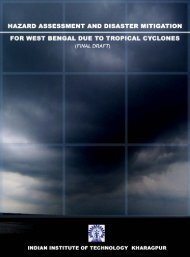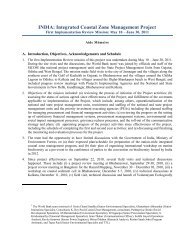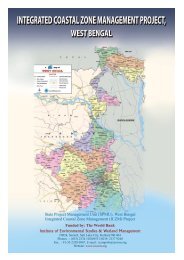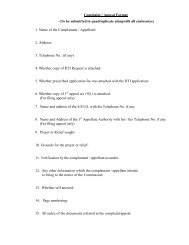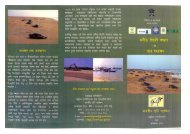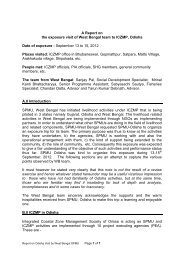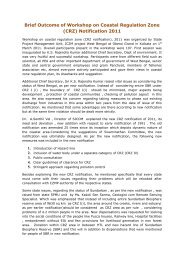integrated coastal zone management project west ... - Iczmpwb.org
integrated coastal zone management project west ... - Iczmpwb.org
integrated coastal zone management project west ... - Iczmpwb.org
Create successful ePaper yourself
Turn your PDF publications into a flip-book with our unique Google optimized e-Paper software.
17spotted deer (Axis axis), dolphins (Platanista gangetica, Orcaella brevirostris,Peponocephala electra, Neophocaena phocaenoides), marine turtles (Caretta caretta,Chelonia mydas, Eretmochelys imbricata, Lepidochelys olivacea and Dermochelys coriacea)and, the flagship species, the Royal Bengal Tiger (Panthera tigris).22. The biodiversity is represented by the following taxonomic groups: over 40 mammalspecies, over 270 bird species, over 45 reptile species, at least 11 amphibian species, over120 fish species, an unknown number of invertebrates, more than 330 plant species. TheSundarban tiger population is supposed to be the largest surviving tiger population in theworld. Estimated number of tigers in the Sundarban is 274 as per 2006 census. The estimatesfor the deer in this area are 50-80,000, for wild boar 20,000, smooth Indian otter (Lutraperspicillata) 20,000 and rhesus monkey (Macaca mulatta) 40,000 to 70,000.23. The colourful bird life along the waterways includes species such as kingfishers (9species), raptors (38 species), herons, egrets, storks, sandpipers, whimbrel, curlew, gulls,terns, woodpeckers, barbets, shrikes, drongosa, mynahs, minivets, babblers and many others.Lucky birders may catch a glimpse of masket finfoot (Heliopais personata).The Sundarban is surrounded by a very densely populated area, therefore human pressure isimportant. Around 1.2 million local users reside seasonally in the area for fishing and otherresource use activities. Commercial hunting was a problem mainly before the 1970s and thisresulted particularly in a serious depletion of the crocodile populations and to a lesser extentto the deer population. Although the protection has improved significantly in the lastdecades, illegal hunting is still occurring on an incidental basis and fishery is having anadverse impact on the populations of the remaining turtle and crocodile populations as theseanimals drown frequently in fishing nets.24. Due to natural processes, fresh water discharge of the Ganges and Brahmaputracatchment is decreasing as main waterways are shifting eastwards (excepting Hugli estuarywhere fresh water of about 40000 cusec flows at least during the driest days through Farakkabarrage). Further, the total annual discharge is decreasing due to intensifying land use(namely irrigation) upstream. The role of this change is not yet clear, but is evident that itwill influence wildlife populations and vegetation in the long term.25. However, the main threat today may come from outside the area in the form ofpollution. Toxic products (pesticides, etc.) enter the system due to upstream pollution in the17






